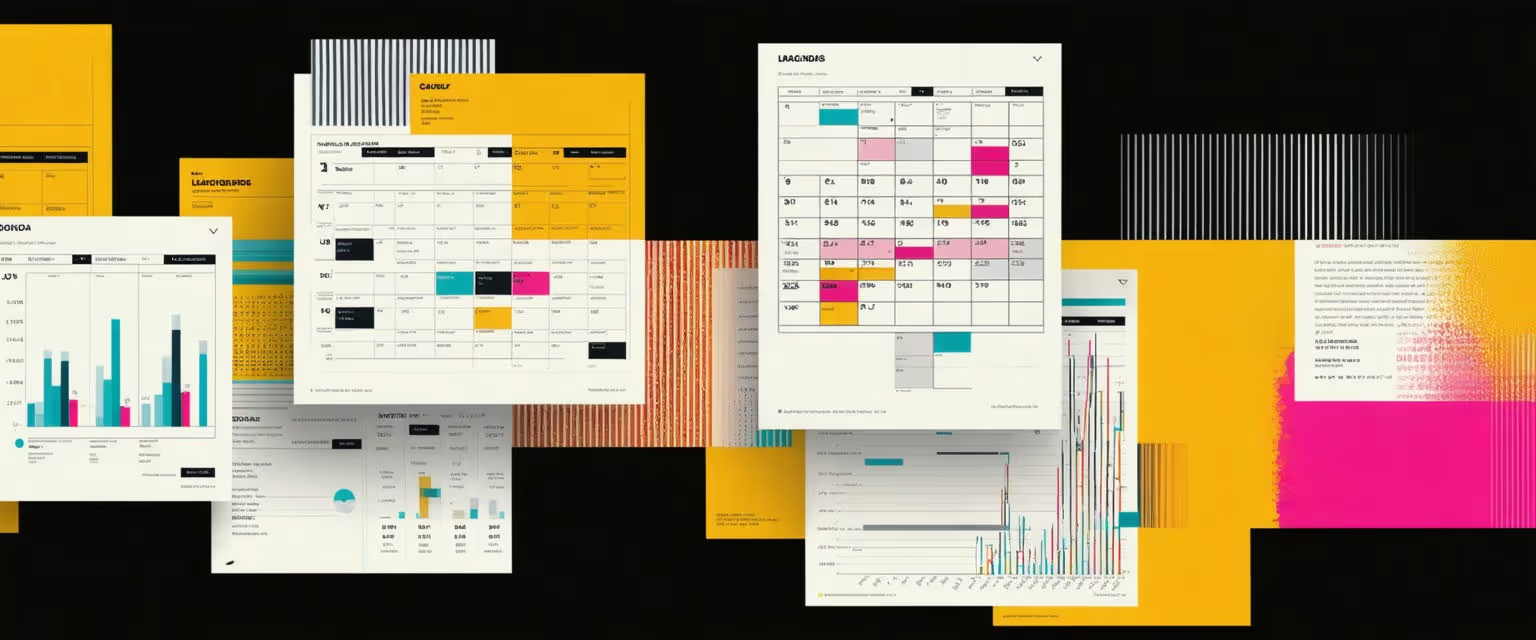All Posts
Marketing document handling
How to Automate Campaign Reports in Marketing: A Step-by-Step Guide

Learn how to efficiently automate marketing campaign reports with AI, saving time, reducing errors, and boosting decision-making accuracy.
Are your sales reports a mess, scattered across multiple platforms and spreadsheets? Manually compiling and analyzing data slows down decision-making, leading to missed opportunities and inefficiencies.
The real challenge isn’t just gathering sales data—it’s integrating disconnected sources into a unified, actionable system without endless manual effort. Thanks to advancements in Agentic AI, automating this process is now easier than ever.
This article explores how AI-powered data connectors streamline sales reporting, eliminate data silos, and help businesses make faster, smarter decisions.
Understanding How Automating Campaign Reports Organization Transforms Marketing
In marketing, reporting has become both essential and problematic. You're likely familiar with the frustration of compiling reports from multiple sources, questioning data accuracy, and spending hours on administrative rather than strategic tasks. Let's explore these challenges and how learning how to automate campaign reports organization offers a compelling solution.
Common Challenges in Manual Reporting
- Error-Prone Data Entry: Transferring data from multiple platforms into spreadsheets increases the risk of mistakes, leading to inaccurate reports and flawed decision-making.
- Costly Mistakes: Small data errors can escalate into costly miscalculations, affecting budget allocations and campaign performance.
- Fragmented Data Sources: With marketing activities spread across various platforms, aligning metrics and creating cohesive reports becomes increasingly complex.
- Time-Consuming Processes: Compiling reports manually can take days or even weeks, slowing down critical decision-making.
- Integration Challenges: Agencies and businesses often struggle to consolidate data from multiple tools, making real-time analysis difficult.
Benefits of Automating Campaign Report Organization
Implementing automation in marketing reporting directly addresses these challenges, offering tangible benefits:
- Significant Time Savings: Automated reporting eliminates hours spent on data collection, allowing teams to focus on strategy and execution.
- Higher Accuracy: Automation removes the risk of human error, ensuring reliable and consistent data.
- Better Decision-Making: Access to real-time, accurate insights helps marketers quickly identify successful campaigns and optimize underperforming ones.
- Optimized Resource Allocation: With less time spent on manual tasks, teams can redirect their efforts toward creative and strategic initiatives.
- Improved Team Morale: Reducing tedious reporting tasks boosts job satisfaction and productivity.
- Scalability: Automated solutions grow with your business, handling increasing data complexity without requiring additional manual effort.
By streamlining campaign reporting through automation, marketing teams can enhance efficiency, reduce errors, and make smarter, data-driven decisions. Investing in automated reporting systems is a strategic move toward a more agile and effective marketing operation.
Building Your Framework for Automating Campaign Reports Organization in Marketing
Creating an effective automation framework for marketing reports isn't just about choosing tools—it's about developing a strategic approach that addresses your specific needs. This three-step framework will help you design a system that saves time, improves accuracy, and delivers actionable insights.
Step 1: Audit Your Current Reporting Workflow
Before implementing any automation solution, you need to understand your existing processes. This audit phase is critical for identifying inefficiencies and improvement opportunities.
Start by mapping your current workflow from data collection to final report distribution:
- Document every data source your team uses (Google Analytics, social platforms, CRM, etc.)
- Track how much time team members spend collecting, processing, and formatting data
- Identify manual processes that could be automated (data exports, spreadsheet manipulations, report formatting)
- Note recurring pain points, such as data inconsistencies or reporting delays
Ask your team members about their challenges with the current reporting process. Those directly involved with report creation can identify bottlenecks that might not be obvious from an organizational perspective.
Step 2: Standardizing Marketing Data Architecture
With a clear understanding of your current workflow, the next step is creating a standardized data architecture. This foundation ensures your automated reports are accurate, consistent, and valuable.
Begin by establishing these key elements:
- Unified naming conventions: Create standardized naming for campaigns, channels, and metrics across all platforms
- Consistent tagging structure: Implement a cohesive UTM tagging framework for all marketing initiatives
- Data dictionary: Develop a central reference that defines all metrics and dimensions used in reporting
- Data validation rules: Establish protocols to verify data accuracy before it enters your reporting system
Fragmented data is one of the biggest obstacles to effective reporting. When different team members use inconsistent naming conventions or tagging structures, generating accurate cross-channel insights becomes nearly impossible.
By standardizing your data architecture, you're not just preparing for automation—you're also improving your marketing intelligence quality. In addition, AI-powered pipeline automation can streamline the data flow between your systems, further enhancing data accuracy and integration.
Step 3: Selecting Your Automation Technology Stack
Once you've audited your workflow and standardized your data architecture, you're ready to evaluate and select the right automation technologies. Rather than focusing exclusively on features, assess potential solutions based on these critical criteria:
- Core functionality: Does the tool cover your essential reporting needs, including segmentation, visualization, and distribution?
- Integration capabilities: How easily does it connect with your existing marketing platforms and data sources?
- Scalability: Can the solution grow with your business and handle increasing data volumes?
- Usability: Will your team be able to adopt the tool without extensive training?
- Customization options: Does it allow for personalized workflows that match your unique reporting requirements?
- Security and compliance: Does the platform meet your data governance and privacy requirements?
Consider a phased implementation approach, starting with automating the most time-consuming or error-prone processes first. Marketing teams using automated reporting save an average of 6+ hours per week on routine tasks—time that can be redirected toward strategic planning and optimization.
Your technology stack might include different solutions for various aspects of the reporting process:
- Data integration platforms to consolidate information from multiple sources
- Visualization tools to create compelling dashboards
- Scheduling tools to automate report distribution
- Analytics platforms to derive insights from raw data
Remember that implementing automation isn't merely a technical challenge but also a change management process. Involve key stakeholders from the beginning, and communicate the benefits clearly.
Implementing Solutions for Automating Campaign Reports Organization in Marketing
For marketing campaign reporting, automation is no longer a luxury but a necessity. The right automation solution can transform how your team handles data, freeing up time for strategic work and improving decision-making capabilities. Here are three distinct approaches to implementing automated reporting systems, each with unique advantages.
Option 1: API-Based Integration Systems
API-based integration systems connect disparate data sources into a unified ecosystem. These systems use Application Programming Interfaces (APIs) to establish direct connections between platforms, allowing for seamless data flow.
Key implementation steps:
- Audit your data sources: Map all your marketing platforms, CRM systems, and analytics tools that need to be connected.
- Select an API integration platform: Look for solutions that offer data connectors to integrate with multiple data platforms, ideal for complex marketing ecosystems.
- Set up data pipelines: Configure connections between systems, defining what data should flow where and how often it should update.
- Implement data transformation rules: Create standardized metrics and KPIs to ensure consistent reporting across channels.
- Create automated triggers: Establish rules for when reports should be generated and distributed to stakeholders. In addition to report distribution, automation can streamline communication processes such as automated email outreach, enhancing engagement with your audience.
The power of API integration lies in creating a "single source of truth" for all your marketing data. When Unilever partnered with Albert.ai to automate their digital advertising efforts, they integrated the platform with their existing marketing tools and data sources.
Best for: Organizations with multiple marketing platforms and data sources that need real-time data synchronization across systems.
Option 2: Marketing Data Visualization Platforms
While API integration provides the foundation for connecting data sources, visualization platforms make this data accessible and actionable through intuitive dashboards and reports.
Implementation process:
- Define reporting requirements: Identify key metrics and KPIs that stakeholders need to monitor.
- Select a visualization tool: Popular options include Tableau, Power BI, Google Data Studio, or marketing-specific platforms.
- Connect data sources: Most visualization platforms offer native connectors to popular marketing tools or can pull data from data warehouses where your API-integrated information is stored.
- Design dashboard templates: Create standardized layouts for different reporting needs (executive summaries, channel-specific reports, etc.).
- Set up automated refreshes: Configure the platform to update dashboards automatically at predetermined intervals.
- Implement sharing protocols: Establish who receives which reports and how (email, direct access, embedded in other tools). Moreover, automating tasks such as PDF conversion can save time and ensure consistency in report formatting and distribution.
When implementing visualization platforms, focus on creating dashboards that tell a story rather than just displaying data. Use visual hierarchies to highlight the most important metrics and include context that helps users understand what they're seeing.
Best for: Teams that need to democratize data access across the organization and require intuitive, visual representations of marketing performance.
Option 3: Custom Automation Solutions
Although pre-built visualization tools offer immediate value, some organizations require more specialized approaches to reporting automation that address unique business needs or integrate with proprietary systems.
Implementation approach:
- Conduct needs assessment: Determine which aspects of your reporting process can't be addressed by off-the-shelf solutions.
- Define technical requirements: Document the specific functionalities, integrations, and outputs needed from your custom solution.
- Select development approach: Decide whether to build in-house (requiring programming expertise in languages like Python or JavaScript) or work with external developers.
- Start with a minimum viable product (MVP): Begin with core functionality and iterate based on user feedback.
- Build data validation mechanisms: Implement quality assurance processes to ensure accuracy of the automated reports.
- Document thoroughly: Create comprehensive documentation for maintaining and updating the system.
Custom solutions make sense when you have unique data sources, specialized calculation needs, or security requirements that off-the-shelf tools can't accommodate. Additionally, you can enhance efficiency by automating other processes, such as automate content brief reviews, freeing up even more time for strategic activities.
When developing custom solutions, prioritize flexibility and scalability. Your reporting needs will evolve, and your solution should adapt without requiring a complete rebuild.
Best for: Organizations with specialized reporting requirements, proprietary data sources, or complex calculation needs that can't be addressed by commercial platforms.
Simplify Marketing Tasks with Agentic AI
Don't let data complexity slow down your team. Datagrid's AI-powered platform is designed specifically for marketing professionals who want to:
- Automate tedious data tasks
- Reduce manual processing time
- Gain actionable insights instantly
- Improve team productivity
See how Datagrid can help you increase process efficiency.
Create a free Datagrid account












